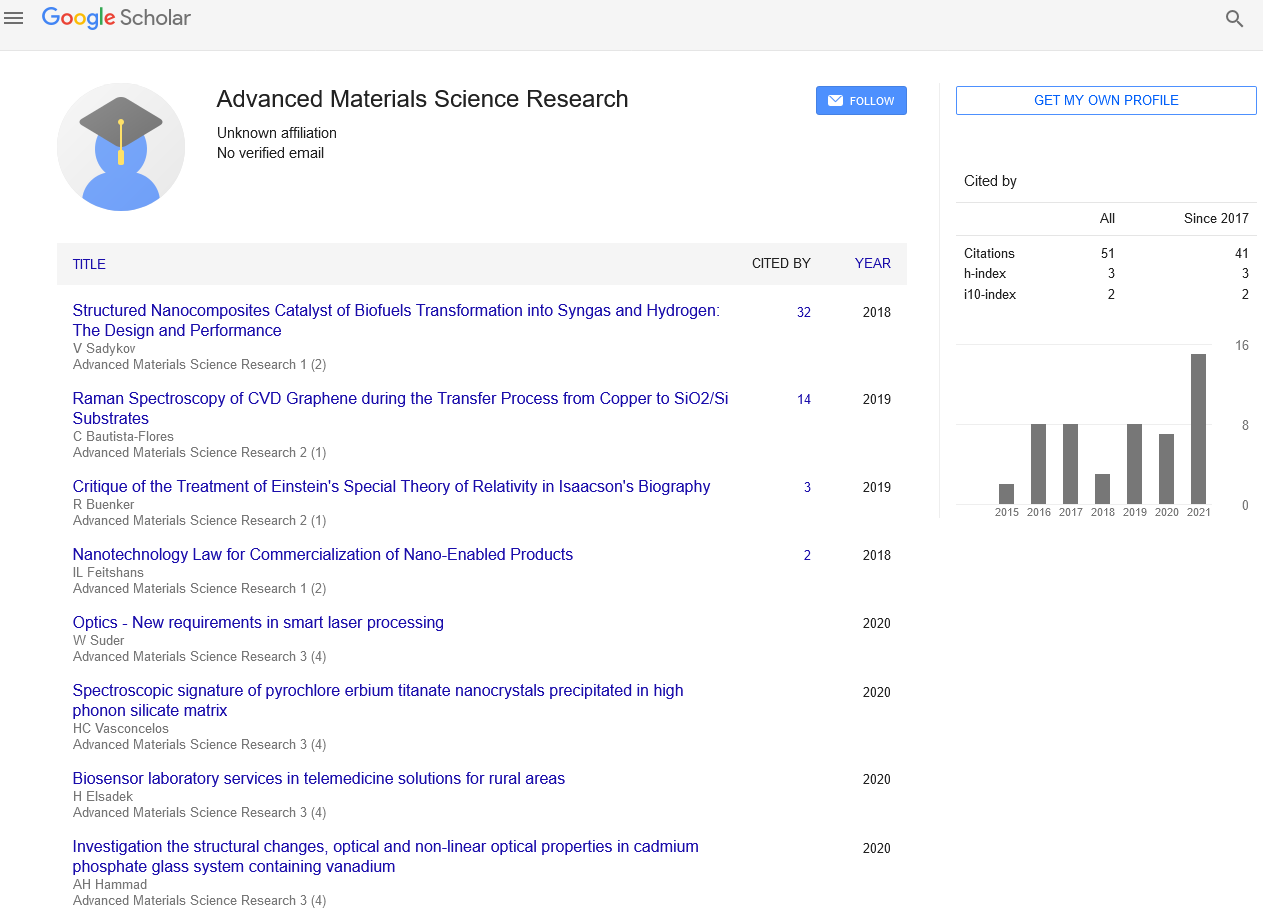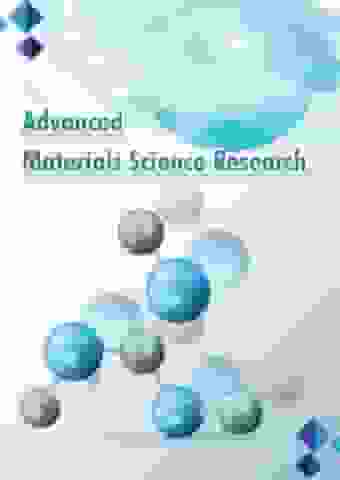Short Communication - Advanced Materials Science Research (2023) Volume 6, Issue 2
Nanostructure Effects on the Mechanical Machining
Velten Fletcher*
Department of biological and biomedical materials, Australia
Department of biological and biomedical materials, Australia
E-mail: Fletcher_v7@gmail.com
Received: 03-Apr-2023, Manuscript No. AAAMSR-23-97147; Editor assigned: 05-Apr-2023, Pre-QC No. AAAMSR-23-97147 (PQ); Reviewed: 19-Apr-2023, QC No. AAAMSR-23-97147; Revised: 21-Apr-2023, Manuscript No. AAAMSR-23-97147 (R); Published: 28-Apr-2023; DOI: 10.37532/ aaasmr.2023.6(2).40-42
Abstract
Due to their outstanding physical and mechanical properties and high process latitudes, metallic materials have been utilized in numerous industrial applications for a long time. Because it has a direct impact on the surface quality of the finished products, mechanical machining is one of the crucial steps in the production of metallic components. Cutting parameters, cooling conditions, and material micro/nanostructures have all been the subject of extensive research into the machinability of metallic materials to date. Cutting parameters and cooling conditions have been extensively examined in previous studies as contributing factors, but a fundamental review of the effects of material micro/ nanostructures on machining is still lacking. As a result, the materials deformation mechanism in the machining of metallic materials is discussed, as is the influence that various micro/nanostructures have on machinability. The crystalline anisotropies of single crystals, the grain sizes of polycrystals, the phase compositions of single and multiphase materials, the layer-by-layer structures of additively manufactured materials, the amorphous structures of bulk metal glasses, the microreinforcements of metal matrix composites, and the porosities of porous metal foams are the primary examples of the micro/nanostructures. In addition, the perspectives of micro/nanostructures are used to discuss the difficulties and opportunities associated with the machining of metallic materials .
Keywords
Nanostructured materials • Mechanical machining • Matrix composites
Introduction
Metals or alloys with lustrous, ductile, electrically and thermally conducting properties are considered to be metallic materials. Due to their excellent properties and widespread distribution on Earth, metallic materials' emergence and development have been crucial to human history. Aerospace, biomedical, military, automotive and agriculture are just a few of the many applications for metallic materials to date. Material miniature/nanostructures are the innate idea of materials, and ordinarily allude to grains, stages and shapeless designs of homogeneous materials, as well as miniature fortifications in the metal grid composites and pores in the permeable metal froths. The yield strength, toughness, hardness, corrosion resistance, and wear resistance of a material can all be significantly impacted by the micro/nanostructures. As a result, the micro/nanostructures of a particular metallic material are closely linked to its applications.
Mechanical machining is a crucial step in the production of metallic parts because it directly affects the surface integrity of the finished products. A CNC machine system, which consists primarily of the CNC software, machine control unit, machine tool or processing equipment, and a few auxiliary devices, is typically used for mechanical machining. Cutting tools that are typically harder than the workpiece are typically used to remove the workpiece during the machining process, resulting in a high surface quality and form accuracy. Mechanical machining techniques like turning, milling, grinding, and drilling have been widely used to make complex geometric shapes and high-precision metallic parts. A multi-axis machine tool, for instance, could easily produce a freeform or complex aspheric surface. Since the modern upheaval of the nineteenth hundred years, metallic materials could be machined on the machine gadget. Currently, the majority of engineering components, including gears, molds, screws, and slide rails, can be efficiently assembled and obtained on the machine processing line, which not only significantly reduces costs but also frees up employees. Moreover, the superior presentation gadgets are forcing severe necessities about the surface harshness and structure exactness for the designing parts, which can likewise be effectively accomplished by the machining. As a result, modern manufacturing relies heavily on mechanical machining procedures.
Based on the cutting parameters and machining precision, machining can generally be divided into traditional and ultraprecision machining. Changes in material micro/nanostructures may have an impact on the machinability of metals or alloys, regardless of whether ultraprecision or traditional machining is used. For example, the decrease of grain measures for the most part brings about high return pressure in view of the Corridor Petch relationship, which regularly leads to high cutting powers in both conventional and accuracy machining. However, the mechanism for removing the material differs significantly. In conventional machining, the material expulsion part contains several grains, so the material evacuation requires composed deformity among grains and no anisotropic way of behaving is introduced. However, the deformation exhibits significant anisotropic characteristics because the grains were individually deformed with ultraprecision at a machining scale close to the grain size. This is a significant trademark in ultraprecision machining of polycrystalline materials, which is known as the grain size impact [1-5].
Discussion
The machinability rating, which determines productivity, machining cost, and materials optimization in mechanical component machining, can be used in the machining process to quantify a material's machinability. The machinability rating can be described in terms of cutting parameters and tool life or expressed as a ratio between the material removal rate and the reference material removal rate. Improvement of cutting boundaries like cutting paces, feedrates and profundity of cut is one of normal techniques to expand the machinability of materials. In addition, selecting the optimal cooling and lubrication conditions, which benefits the interaction between the cutting tool and workpiece and lowers the machining temperature, can also improve machinability. High temperature is typically created in the slicing zone because of the communication between the cutting device and workpiece, particularly for the rapid machining, which presents extraordinary dangers to the surface quality and layered precision of the workpiece. All the more significantly, high temperature likewise impressively decreases the device life, so ideal cooling/grease conditions ought to be viewed as cautiously in the machining system.
Because material micro/nanostructures directly determine the material's mechanical properties, a material's machinability is also significantly impacted by cutting parameters and cooling/ lubrication conditions. Cutting parameters and cooling/lubrication conditions have been well covered in previous review studies. This review aims to provide a comprehensive overview and state-of-the-art regarding how micro/ nanostructures affect machinability based on numerous previous studies in the machining of metallic materials from perspectives of grains, phases, layer-by-layer structures, amorphous structures, micro reinforcements, and porosities of various metallic materials. However, there is no comprehensive review summarizing the effects of material micro/nanostructures on the machining. Cutting forces, surface roughness, subsurface damage, dimensional accuracy, cutting temperature, and chip formation all play a role in determining machinability. In addition, issues and perspectives related to material deformation mechanisms are highlighted and discussed for the purpose of upcoming studies and applications.
It is challenging to investigate the effects of material anisotropy on the material removal mechanism in polycrystal precision and ultraprecision machining because polycrystalline materials typically contain a large number of grains. An alternative method for deciphering the material effects on the machining is to machining single crystal metals or alloys without grain boundaries. In addition, single crystals have been utilized in industry as electrical conductors, turbine blades, and mirrors due to their distinct characteristics, which include superior electrical and conductive properties in comparison to polycrystalline materials. As a result, machining single crystals has received a lot of attention and has been extensively researched in recent decades, particularly in ultraprecision machining with very little material removal [6-10].
Conclusion
The most important property of single crystals is material anisotropic behavior, which is caused by the different physical and chemical properties in different crystalline orientations and planes. Body centered cubic (BCC), face centered cubic (FCC), and hexagonal closest packing (HCP) are the three most prevalent crystalline structures found in metals. Throughout recent many years, the greater part of studies center around exploring the machinability of the single gem metals with FCC translucent designs, essentially including single gem copper (Cu), aluminum (Al), and nickel (Ni) superalloy.
References
- Willcutt EG, Doyle AE, Nigg JT et al. Validity of the executive function theory of attention-deficit hyperactivity disorder: A meta-analytic review. Biol Psychiatry.57, 1336–1346 (2005).
- Barch DM, Ceaser A. Cognition in schizophrenia: Core psychological and neural mechanisms. Trends Cogn Sci.16, 27–34 (2012).
- Aron AR. The neural basis of inhibition in cognitive control. Neuroscientist.13, 214–228 (2007).
- Mill RD, Ito T, Cole MW. From connectome to cognition: The search for mechanism in human functional brain networks. Neuroimage.160, 124–139 (2017).
- McTeague LM, Huemer J, Carreon DM. Identification of common neural circuit disruptions in cognitive control across psychiatric disorders. Am J Psychiatry.174, 676–685 (2017).
- Green MF, Kern RS, Braff DL. Neurocognitive deficits and functional outcome in schizophrenia: Are we measuring the right stuff. Schizophr Bull. 26, 119–136 (2000).
- Castellanos FX, Sonuga-Barke EJ, Milham MP. Characterizing cognition in ADHD: beyond executive dysfunction. Trends Cogn Sci. 10, 117–123 (2006).
- Ferrante M, Redish AD. Oquendo Computational psychiatry A report from the 2017 NIMH workshop on opportunities and challenges. Mol Psychiatry. 24, 479–483 (2019).
- Miyake A, Friedman NP, Emerson MJ. The unity and diversity of executive functions and their contributions to complex frontal lobe tasks A latent variable analysis. Cogn Psychol. 41, 49–100 (2000).
- Hull R, Martin RC, Beier M. Executive function in older adults A structural equation modeling approach. Neuropsychology. 22, 508–522 (2008).
Indexed at, Google Scholar, Crossref
Indexed at, Google Scholar, Crossref
Indexed at, Google Scholar, Crossref
Indexed at, Google Scholar, Crossref
Indexed at, Google Scholar, Crossref
Indexed at, Google Scholar, Crossref
Indexed at, Google Scholar, Crossref
Indexed at, Google Scholar, Crossref

